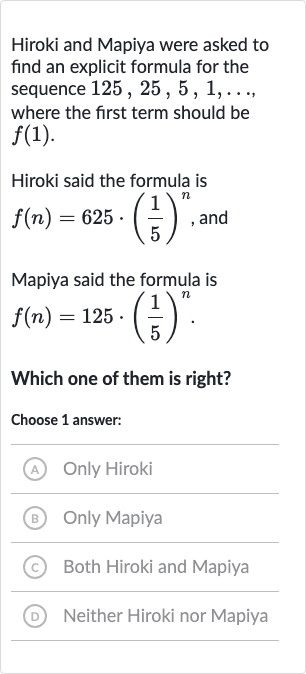AI tutor
Welcome to Bytelearn!
Let’s check out your problem:

Hiroki and Mapiya were asked to find an explicit formula for the sequence , where the first term should be .Hiroki said the formula is , andMapiya said the formula is .Which one of them is right?Choose answer:(A) Only Hiroki(B) Only Mapiya(C) Both Hiroki and Mapiya(D) Neither Hiroki nor Mapiya
Full solution
Q. Hiroki and Mapiya were asked to find an explicit formula for the sequence , where the first term should be .Hiroki said the formula is , andMapiya said the formula is .Which one of them is right?Choose answer:(A) Only Hiroki(B) Only Mapiya(C) Both Hiroki and Mapiya(D) Neither Hiroki nor Mapiya
- Identify the pattern: We have the sequence: Identify the pattern in the sequence.
- Determine first term and common ratio: The sequence is geometric because each term is obtained by multiplying the previous term by a common ratio.Determine the first term () and the common ratio ().First term: Common ratio:
- Test Hiroki's formula: Now, let's check Hiroki's formula: Test Hiroki's formula with to see if it gives the first term of the sequence.Hiroki's formula gives the correct first term.
- Test Mapiya's formula: Next, let's check Mapiya's formula: Test Mapiya's formula with to see if it gives the first term of the sequence.Mapiya's formula does not give the correct first term.
- Conclusion: Since Hiroki's formula gives the correct first term and follows the pattern of the sequence, Hiroki is correct.Mapiya's formula does not give the correct first term, so Mapiya is incorrect.
